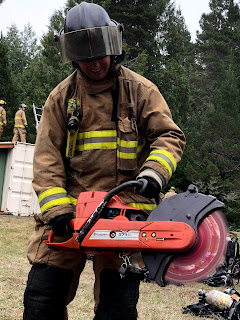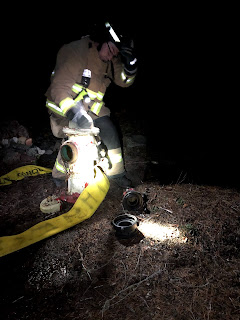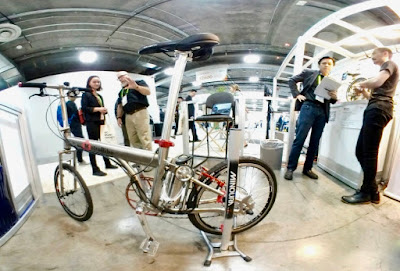Sunday. This is the last day of my week of being team lead for the class. I'm pretty sure that I'll still get there early and wander out when I've got things put away, but it'll be a bit easier not having to pay so much attention to the tasks that the role requires. Onto the day, before the details slip from my memory.
I didn't make it under the two-minute mark on any of the turn-outs and air pack drills this morning. Close, but still a bit over. I think it is directly related to the fact that I still ached in every joint from Saturday's session or it could be that I am just slow. Either will work.
We loaded up the air packs into the rescue truck and headed over to Station 4 off of Sutton Lake Road to do more fire box training. Today, working on techniques of venting the structure from the inside to clear the smoke and help direct the fire. Along with that comes the drill of arrival on scene activities and what each team needs to do. It is clear that the academy will give us enough knowledge and experience to be helpful and somewhat safe, but Tuesday night drills throughout the year are going to be important. My role did not include going inside the fire box during the morning session.
Just as our lunch hour began, the station received a rescue call for an accident on the dunes. At least that's what I figured it was when I saw them going down the highway Code 3 with the trailer full of quads. This situation took most of our trainers with it, so the captain changed things up for the afternoon.
Instead of continuing to run exposure drills into the burn box, we did a rotation of three other areas. Forced entry, saws and cutting equipment, and roof access/assessment/ventilation.
The key to forced entry is to assess the situation first before you just break down the front door. Where is the fire concentrated? How far involved is it? Is the door unlocked? Is it possible to just break a window to allow unlocking the door from the inside? Like most things, the more you know the more empathy you have for someone who's decisions looks like it wasn't the best when viewed from the armchair in review.

If it is the front door that needs to be gone through because that's what's determined to be the best route to fight the fire, a series of steps needs to be gone through to protect the firefighter while quickly gaining entry. First off, check for heat at the door by exposing the back of the gloved wrist. Starting at the bottom of the door and moving towards the top, feel for heat. This process determines how close or how involved the fire is getting. If the heat is only at the top of the door, then there is the possibility of a rescue. If it is hot at the bottom, that chance has passed and the fire is very close. Once the strata of heat has been determined and the decision made to go in, the lead firefighter tries to open the door using the door handle--"Try before you Pry." If locked, they then use a
Halligan to purposely determine where the locks and bolts are on the door. "Purposely" means to slam the Halligan into the bottom, middle and top of the door to see where it flexes and where it does not. The Halligan is going to be used where it does not flex.
The exercise is set up to simulate a normal dead bolt and handle set-up and what it takes to break the door jam. If there are pins in the door at the top and bottom, then you would start at the bottom and work your way up. Back to a "normal" set-up, the Halligan adze blade is placed between the deadbolt and lock set. The second firefighter steps up with the
flathead axe and strikes the back of the adze when the first firefighter says "STRIKE." Once the adze is set sufficiently into the jam, the first firefighter rotates the Halligan upwards to break the jam. When the door is free, the firefighter reaches in with the Halligan and gains control of the door to prevent it being sucked in by the fire. Maintaining control of the door with the Halligan, the door handle is grabbed before removing the Halligan. Testing for positive or negative pressure on the door to determine fire conditions before doing the LLL entry is required for safety.
LLL--Oh, how we love our acronyms--is Life, Layout and Location. The initial entry into the structure is done low, very low. With one foot hooked on the door jam to gauge how far into the room you're going and prevent you from going further so that you can be pulled out if needed, the first firefighter in searches in all directions possible with their hands to determine if there is someone directly behind the door who was trying to get out and failed to do so. Simultaneously, they are determining the Layout of the room if possible and attempting to determine the Location of the fire. Then, as quickly as possible, they get out to report their findings to the rest of the entry team.
Besides the "normal" forced entry, we went over alternative methods. Kicking the door in was demonstrated and was offered up for us to try if we wanted. I like my knees, so I chose to use the tool instead. Inward facing door, such as a locked interior door, entry was demonstrated and we got to try that too. If all else fails, the
K-12 tool could be used to cut through the door locks or pins.
At the next rotation station, we went over the starting, use, and prepping for storage of chain saws and the K-12 tool. Even though it should have been put away correct and it takes a few seconds to check again, first check to make sure that there is fuel and oil in the saw. It does no good to bring a saw to where it's needed only to have it not start or not have it run for long enough to do the job. The chainsaw we use is a l
ight, powerful Husqvarna with what looks like a 24" bar. Set the chain brake. Place foot on the lower handle area. Pull the choke out which automatically opens the shutoff switch. Press the compression release button. Pull once. Close the choke and reset the compression release button. Pull again to start. Hope the thing starts. Curse the person who did I&M (Inventory and Maintenance) last if it doesn't.
The K-12 tool (see link above), has a 24" rotating blade and is used to cut metal. Metal doors, roofs, rebar, car bodies, etc. The starting procedure is similar to the chainsaw with the exception that there is no bar oil and no brake for the blade. Due to the high RPM (Revolutions Per Minute) and large diameter blade, centrifugal force is a real danger. The saw cannot be moved quickly while spinning at high RPMs. Know how you are going to move the saw and where you're going to cut before getting the saw spun up.
Putting the saws away require that fuel and oil tanks be filled, the chokes pulled out, compression buttons pushed in and switches set to run. If the blades or chains were damaged in use, they need to be changed. This makes the saw ready for the next time it is pulled out and needs to be used. The next call may happen on the way back to the station.
Our last station of the day, was roof access and ventilation. The training area has a 40-foot shipping container--the one used for the smoke rescue training--that has a wood roof with an 8 and 12 pitch attached to the side of it. A 12 and 12 pitch has a 45 degree angle and an 8 and 12 pitch has about a 34 degree angle to it. This composition shingled roof has a opening already cut into it simulating the area size that a ventilation hole would be cut if needed for fire control. While we didn't actually cut into a roof, we were able to see how and why we would be cutting into a roof for ventilation.

First off, a ladder needs to be set with at least five rungs above the roof level in order to safely get onto the roof. A two-person team is recommended to set a 24-foot extension ladder. Even though we already have had ladder training, it was clear that a refresher was already needed. I know I had forgotten more than a few steps--no pun intended. The lead firefighter climbing first--"FIREFIGHTER CLIMBING"--is carrying a
trash hook to sound the roof making sure it's safe for team to follow.
Sounding the roof is similar to finding a stud in your wall to hang a picture. A hollow sound indicates that there is a hollow area underneath or a weak area. A solid sound is given when there is a rafter underneath. Also, looking for indications of heat and smoke. Once the roof has been determined to be safe, the rest of the team begins climbing the ladder with the other tools and non-charged fire hose. Other tools include a roof ladder, which has hooks to go over the ridge of the roof and a chainsaw or K-12 needed to cut the hole for ventilation. Once the roof ladder is set on the up wind side of where ventilation is planned, the team lead descends using the ladder rungs for safety and sounds the roof with the trash hook looking for the rafters and marking the area to be cut for ventilation. When a bit past the bottom of where the cut needs to be made, the team lead plants one side of the trash hook firmly into the roof and places the D-handle end on top of their foot. Their foot is securely placed on a rung of the roof ladder. This is a safety and walk rail for the firefighter who is going to be doing the cutting.

The firefighter with the chainsaw descends the ladder and makes the first cut across the bottom riding the bar over the rafter as much as possible so as not to reduce the structural integrity of the roof. The second cut is on the far side along the inside of the far rafter. The third cut is on the near side rafter next to the roof ladder. The last cut is along the top, again trying to ride the bar over the rafter in the middle so as not to cut through it. The first firefighter then calls on the radio to coordinate ventilation. The coordination is essential to avoid putting the firefighters in the building in harms way by introducing ventilation between them and the fire. When the go-ahead has been given, the the lead firefighter uses the trash hook to punch through the near side of the ventilation cuts to open the hole in a butterfly-valve fashion. The part of the valve that above the roof line should be downwind of the roof ladder. If there is no smoke resulting from the opening, then there are other layers of ceiling or roof that need to be punched though or cut to provide the needed ventilation.
Travelling down the ladder with tools in hand required a bit of instruction on where to place the hand with the tools and how to hold them to safely carry them down. The hand with the tool slides down the rail of the ladder, while the other one is on the rung as you go down.
The class has this clean up thing down. Air packs were scrubbed and and tanks filled. All engines had air packs replaced and set up for readiness. The masks and regulators cleaned and sanitized. House swept, vacuumed, and bathrooms cleaned, Radios put away with channels set to "1", placed in "off", and properly set into charger. "18-03!" "WHO YOU WANT TO BE!"





























